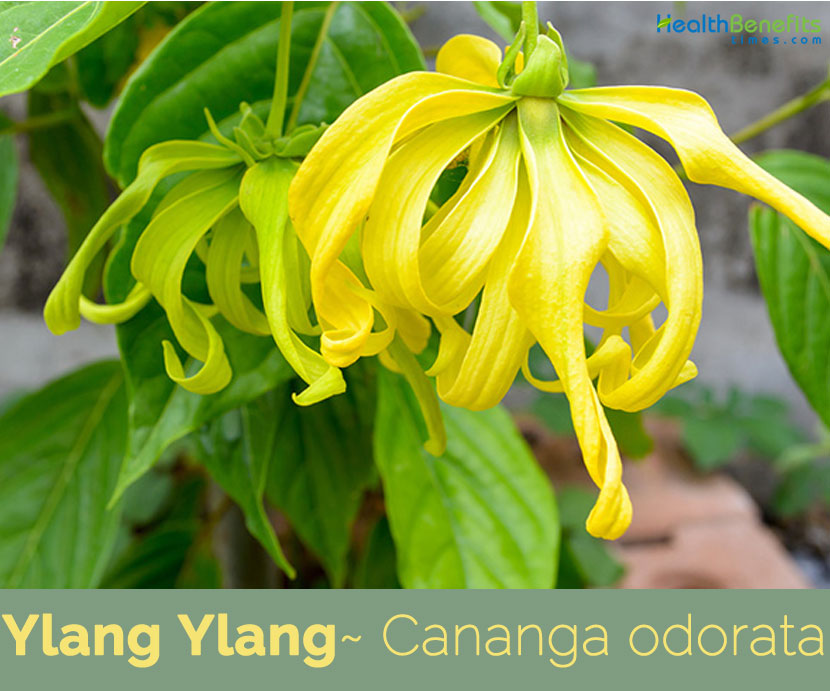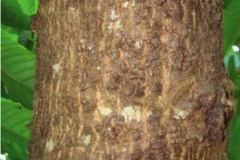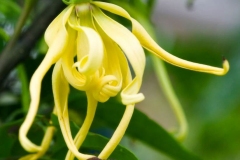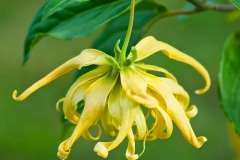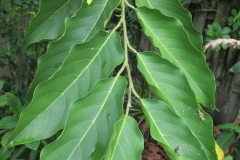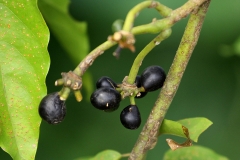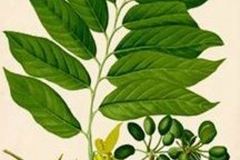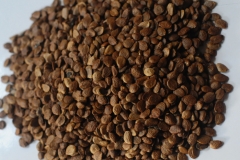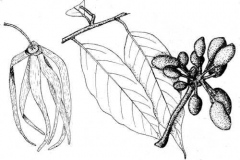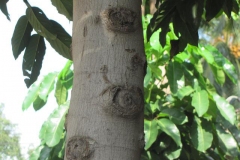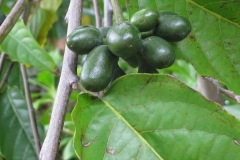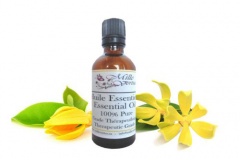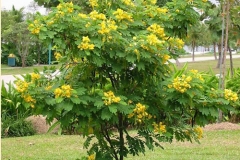| Ylang Ylang Quick Facts | |
|---|---|
| Name: | Ylang Ylang |
| Scientific Name: | Cananga odorata |
| Origin | India, through parts of Indochina, Malaysia, the Philippines and Indonesia, to Queensland, Australia |
| Colors | Dark green when young turning to black when ripen |
| Shapes | 1.5-2 cm long, 1.3-1.4 cm in diam., broadly ellipsoid to broadly obovoid, purple-black and juicy when ripe |
| Flesh colors | Yellow |
| Taste | Bitter |
| Health benefits | Good for fever, blood pressure, malaria, asthma, various skin conditions, conjunctivitis, hypertension, stomach pains, migraine headache, indigestion, colic, impotence, frigidity and toothache |
| Name | Ylang Ylang |
|---|---|
| Scientific Name | Cananga odorata |
| Native | India, through parts of Indochina, Malaysia, the Philippines and Indonesia, to Queensland, Australia |
| Common Names | Apurvachampaka, Cananga, Chettu sampang, Ilang-ilang, Kananga, Karumugai, Kradanga, Lanalana, Llang-Llang, Macassar Oil Tree, Maso’oi, Moso’oi, Muso’oi, Perfume Tree, Sa’o |
| Name in Other Languages | Arabic: Yulanij (يلانج) Austral: Motoi Bengali: Aparūpa cām̐pā (অপরূপ চাঁপা) Brazil: Ylang ylang Burmese: Sagasein Cambodia: Chhke sreng Carolinian: Lengileng Catalan: Ilang-ilang Chamorro: Alang-ilang, alangilang, ilang-ilang, ilangilang Chinese: Xiao yi lan, yi lan, yuan bian zhong Chuukese: Pwalang, pwanang, pwuur Cook Islands: Mata’oi, mato’oi, moto’oi Czech: Kananga vonná Danish: Ylang-Ylang English: Fragrant cananga, Macassar oil plant, Ylang-ylang, Ylang-ylang tree, ilang-ilang, fragrant cananga, Macassar Oil Plant, Macassar oiltree, Perfume Tree, woolly pine, Matches stick tree Esperanto: Odora kanango Estonian: Lõhnav Kananga Fijian: Makasoi, makasui, makosoi, makosui, makusui, mokohoi, mokosoi, ylang-ylang Filipino: Ylang-ylang Finnish: Tuoksuilangia French: Canang odorant, Ilang-ilang, Ilang-ilang de Bornéo, Ilang-ilang des Philippines, Ilang-ilang en arbre, Ylang-ylang Georgian: Ilang-ilangi (ილანგ-ილანგი) German: Ilang-Ilang, Ilang-Ilangbaum, Ylang-Ylang, Canangabaum, Ylang-Ylangbaum Hawaiian: Lanalana Honduras: Ilán-ilán IIocano: Ilang-ilang India: Apurvachampaka, chettu sampangi, karumugai Indonesian: Kenanga, kernanga, sepalen, kananga wangoa, lomulihano, bunga kaeik, Kananga, sandat, sandat Kananga, sandat wangsa, tenaga, amok, kananga, lalingiran, raringidan, wonggulita, amok, kanang, lalingiran, raringidan, wonggulita Japanese: Iraniran noki, Ban reishi, iraniran (イランイラン) Javanese: Kembang kenanga Kannada: Apurva champaka (ಅಪೂರ್ವಚಂಪಕ), Katte sampinge (ಕತ್ತೆಸಂಪಿಗೆ), Kananga (ಕನಂಗ) Komi: Ilang-ilang (Иланг-иланг) Kosraean: Ilahnglahng, ilanlang Kwara‘ae: Sa‘o sa‘o Laotian: Ka dan nga thay Lithuanian: Kvapioji kananga Malay: Bungan sandat (Bali), Kananga, Kenanga utan, Pokok Kenanga Malaysia: Chenanga, kenanga, kenanga utan, ylang-ylang Malayalam: Lāṅgi lāṅgi (ലാംഗി ലാംഗി), Kattuchempagam Maori (Cook Islands): Mata‘oi, mato‘oi, moto‘oi Marathi: Chape Marquesan: Moto‘i Marshall Islands: Ilanlan Marshallese: Ilañlañ Micronesia: Pwalang, pwanang, pwuur Micronesia/Pohnpei: Pur-n-wai, pwurenwai, sair-n-wai, seiren wai, seirin wai Myanmar: Kadapgnam, kadatngan, kadat-ngan, kadatnyan, sagasein, saga-sein Nauruan: Derangerang, derangirang Nicaragua: Flor de Ilán Niuean: Motōi, motoi, motooi Other: Alang-ilang Palauan: Chiráng, ilang-ilang, irang Persian: درخت کانانگا Philippines: Alangilang Pohnpeian: Pur-n-wai, pwurenwai, sair-n-wai, seiren wai, seirin wai Polish: Jagodlin wonny Portuguese: Cananga, Ilanga, Ilangue-ilangue, batata-doce, Ylang ylang, Árvore-perfume Puerto Rico: Alang ilang, alingilang, Ilanilan Romanian: Ylang-ylang Russian: Ilang-Ilang (Иланг-иланг), Kananga duchistaia, Zheltyi Ilang-Ilang Samoan: Moso‘oi Solomon Islands: Sa‘o sa‘o Spanish: Alangilán, Cadmia, Cananga, Ilang-ilang, Ylang-ylang, Ilang-ilang, Cadmia Sundanese: Kananga Swedish: Ilang-ilang Tagalog: Ilang-Ilang, Alangilan Tahitian: Mata‘oi, mato‘oi, moto‘i, moto‘oi, motoi, y‘lang y‘lang, ylang ylang Tamil: Maṉōrañcitam (மனோரஞ்சிதம்), Kattu chempakam (க்ட்டு சம்பகம்), Kadi, Karumugai Telugu: Apurva champakame, Chettu sampangi, Chettu Sampangi Apurvachampakama, Apurva Champakame Thai: Fereng, Kradang nga thai, Kradạngngā (กระดังงา), kradangnga-songkhla, kradangnga-thai, kradangnga-thai, sabannga-ton Tongan: Mohokoi Tuamotuan: Motoi, muto‘i Ukrainian: Ilanh-ilanh (Іланг-іланг) USA/Hawaii: Lanalana Vietnamese: Hoàng lan, ho[af]ng lan; ng[oj]c lan t[aa]y Wallisian: Mohokoi, mosokoi |
| Plant Growth Habit | Fast-growing, straggling, pendulous evergreen tree |
| Growing Climates | Gullies and on slopes, in forest and on its edges, moist evergreen forests and teak forests |
| Soil | Deep, well-drained soils are required for the plant’s long taproot but the species can tolerate a wide range of soils including rich volcanic, fertile sands, clay loams and clays. It can tolerate shallow and infertile soils as well as short-term water logging but cannot tolerate permanent marshy or wetland conditions, or saline or alkaline soil |
| Plant Size | Up to 40 m (130 ft.) tall with a trunk diameter of 75 cm (2.5 ft) |
| Root | Long taproot |
| Stem | Pendulous, pubescent when young, striated with age |
| Bark | Light brown or greyish, smooth in young trees, in mature trees fissured and rough. |
| Leaf | Blade narrowly ovate to oblong-elliptic, (5-)10-22 cm long, 2.5-9 cm wide, chartaceous, dark green when fresh, oblong to lanceolate or elliptic, with 5-10 pairs of lateral veins, glabrous or glabrate above |
| Flowering season | June-July |
| Flower | Flower is drooping, long-stalked, with six narrow, greenish-yellow (rarely pink) petals, rather like a sea star in appearance |
| Fruit Shape & Size | 1.5-2 cm long, 1.3-1.4 cm in diam., broadly ellipsoid to broadly obovoid, purple-black and juicy when ripe |
| Fruit Color | Dark green when young turning to black when ripen |
| Flesh Color | Yellow |
| Propagation | By Seed or cuttings |
| Flavor/Aroma | Tropical, fruity, fatty, sweet, and floral |
| Seed | Pale brown, oblong-elliptic in outline, flattened, 9 mm. long, 6 mm. wide, 2.5 mm. thick, with rugose or pitted faces. |
| Taste | Bitter |
| Plant Parts Used | Flowers, Essential oil |
| Season | October-November |
| Health Benefits |
|
| Precautions |
|
Plant Description
Ylang Ylang is a fast-growing, straggling, pendulous evergreen tree that normally grows up to 40 m (130 ft.) tall with a trunk diameter of 75 cm (2.5 ft.) with an irregularly-shaped crown and a sometimes drooping, brittle branch formation. When grown for perfume extraction, it is normally not more than 3 m tall. The trunk is generally cylindrical in shape up to the first branch and without buttresses. The plant is found growing in gullies, on slopes, in forest, on its edges, moist evergreen forests and teak forests. Deep, well-drained soils are required for the plant’s long taproot but the species can tolerate a wide range of soils including rich volcanic, fertile sands, clay loams and clays. It can tolerate shallow and infertile soils as well as short-term waterlogging but cannot tolerate permanent marshy or wetland conditions, or saline or alkaline soil.
Bark and wood
The bark is smooth when young, becoming fissured and rough as they mature, and variable in color from light or dark brown to greyish or silvery. Inner bark is yellowish to light brown, with prominent bast fibers, and has a slightly bitter taste. The wood is light; averaging 0.48−0.56 g/cm3 air-dry, pale greyish to yellowish in color with a pinkish tinge. The sapwood and heartwood are not distinct. The grain is straight with a coarse texture. Growth rings are inconspicuous, and pores are usually very few and variable in size from moderately small to large, evenly distributed, isolated and in radial groups of 2−4 or more, open with simple perforation plates; soft tissue occurs mainly in very fine, inconspicuous lines between the broad, low, widely spaced rays between which are found two rows of pores. The wood is easy to work, soft and highly perishable. Shrinkage during seasoning from green to air-dry averages1.5 % radial and 4 % tangential
Leaves
The leaves are dark shiny green above, duller, lighter, and slightly pubescent beneath, simple, alternate, ovate-oblong to broadly elliptic, 9−21 cm in length and4−9 cm wide, with wavy margins, a rounded and usually unequal base, and finely acuminate apex. As with most other members of the family Annonaceae, the leaves are arranged on a single plane along twigs. Petioles are light green, 6−15 mm long. The leaf mid -rib is prominent, with 7−12 pairs of lateral veins at an angle of 45º to the midrib. The twigs are light green when young, becoming brown, and have a slightly spicy taste.
Flowers
The highly fragrant, drooping flowers are approximately 7.5 cm long and borne in groups of 4−12 together in hanging axillary, umbellate clusters scattered along the older parts of twigs at leaf bases or from the branches behind the leaves. Pedicels are 1−2.5 cm long, elongated in fruit. The calyx has three broad, pointed, hairy yellow-green sepals that are 0.6 cm long, spreading and slightly turned back, and six slightly thickened, strap like, twisted, pointed, slightly hairy petals usually 4−6 cm long (sometimes up to 8 cm). The petals are arranged in two series of three each, the outer ones usually 8−12 mm wide, the inner ones 5−7 mm wide. Green when young, the petals turn yellow and finally yellowish-brown and drooping, with a reddish-brown blot at the base of the three inner petals when mature. The flowers have numerous stamens less than 3 mm long that are pointed and becoming reddish tinged at the apex, crowded into a triangular mass along with 8−15 separate green pistils that are less than 6 mm long and whose stigmas are also crowded together. Flowering normally takes place in between June-July. Tree doesn’t flower for its first five years; after this it goes on to produce an amazing 45 pounds of flowers for around fifty years!
Fruit
Several fruits develop from each flower. These compound fruits are comprised of 6−12 (occasionally up to 20) berries borne in axillary clusters. The fleshy, olive-like berries are ovoid or obovoid about 1.5−2.3 cm long, 1.3-1.4 cm in diam., glabrous and juicy. Fruits are green when young turning to blackish when ripe. Each fruits consist of about 2−12 (usually 4−5) hard, flattened ovoid, pale brown, and pitted seeds that are 6 mm or more in diameter, arranged in two rows, embedded in an oily nearly tasteless yellow pulp.
Seed weights are variable, with reported averages ranging from 14,000−21,000 per kilogram. In its native habitat in lowland southeast Asia the fruits are eaten by small mammals such as squirrels, bats, monkeys and frugivorous birds, which disperse the small hard seeds
The plant is cultivated throughout the tropics and subtropics in gardens for its exceptionally fragrant flowers, from which are distilled essential oils used in perfumes, soaps, shampoos and other cosmetic products, foods, and aromatherapy.
Health benefits of Ylang Ylang
Listed below are popular health benefits of using Ylang Ylang
1. Good Aphrodisiac
As all of us don’t know that Ylang Ylang is often used as an aphrodisiac. It is found in several Eau de toilettes and perfumes due to its powerful scent which encourages attention from the opposite sex! It is believed to increase libido and attraction because of its energizing properties. Ylang Ylang is an excellent example of an essential oil that improves levels of happiness and creates desire! It’s no coincidence that in areas of Asia it is used in marriage ceremonies to represent love. As an aside, if you’re considering for essential oil as an aphrodisiac mix Ylang Ylang with Rose, Neroli, and Jasmine.
2. Stress and Depression Reliever
Ylang Ylang is known to reduce stress and slow down a rapidly beating heart so if someone is in shock. This essential oil has a superb relaxing influence. Not only does it alleviate stress symptoms but it is excellent for those who are suffering from depression because it is believed to re-balance energy by restoring peace. It was extensively used in ancient medicines to combat a depressed mood because it uplifts the mood and encourages a feeling of hope.
3. Used as Antiseptic
Keep a small bottle of Ylang Ylang handy in your medicine cabinet because this essential oil is exceptional in protecting wounds from bacterial infections as well as fighting viral infections and fungus. Furthermore, it is broadly used to help the healing process of cuts and grazes.
4. Helps You Sleep
As previously mentioned, Ylang Ylang has many relaxing properties so is frequently used to help insomnia because of its sedative nature. It calms and reduces nerves and anxiety so induces a deeply relaxed state and can in many cases help those who suffer from sleeplessness, enjoy hours of blissful snoozing! Place a couple of drops on your pillow and see if it works for you.
5. Relieves Eczema
Some eczema can be reduced by Ylang Ylang which has anti-inflammatory properties and helps to relieve skin irritation and redness as well as treating eczema as well.
Traditional uses and benefits of Ylang Ylang
- Ylang Ylang is used against fever, blood pressure, malaria, asthma, various skin conditions, conjunctivitis, hypertension, stomach pains, indigestion, colic, and toothache among others.
- Flowers, and the essential oil obtained from them, are anti-pruritic, anti-fungal, antiseptic and sedative, relieving tension, lowering blood pressure and reducing fever.
- They are also said to be aphrodisiac.
- Applied externally, they are used to treat skin irritations, conjunctivitis, boils and gout.
- They are added to bath water to treat impotence and frigidity.
- Essential oil is significant in aromatherapy, where it is used in the treatment of tachycardia, rapid breathing, hypertension, gastrointestinal infections and psycho-sexual complaints.
- Flowers are harvested of a night time and dried for infusions or distilled for their essential oil.
- Leaves are used in a treatment for diarrhea in infants.
- Leaves are also used in a remedy for treating boils.
- They are rubbed on the skin to treat itch.
- Bark is applied against scurf.
- An infusion of the bark is used for treating stomach ailments such as pains, indigestion and colic.
- Fluid from the pressed bark is used in treating toothaches and migraine headaches.
- The seed has been used externally to cure intermittent fever.
- It is believed to relieve high blood pressure and normalize sebum secretion for skin problems.
- Dried flowers are used to treat malaria in Java and Vietnam.
- The bark of the plant is said to be effective in treating stomach problems.
- In Java, the dried flowers are used to treat malaria and malaria-like symptoms.
- It has been also reported that the pounded fresh flowers paste can be used to treat asthma.
- Flowers and bark of C. odorata are used to treat pneumonia and stomach ache by the local communities and traditional healers from Northern Mariana Islands.
- In Indonesia, ylang-ylang oil is used to enhance euphoria feel during sex and also reduce sexual anxiety.
- Ylang-ylang has been reported to be used as antidepressant to treat depression and nervousness.
- Leaves are believed to relieve itchiness by direct topical application and also to treat dandruff.
- Indian has also used ylang-ylang oil to treat headaches, eye inflammation, and gout.
- Traditional healers from Papuan New Guinea believe that by consuming the decoction of the heated inner bark of C. odorata is able to treat gout.
- Indian used the decoction of the bark of the plant to treat rheumatism, phlegm, ophthalmia, ulcers, and fevers.
- Ylang Ylang has a positive effect on the Immune health, blood flow and emotions.
- It improves the blood flow in the body and fights Inflammation.
- Its essential oil is used for controlling Blood Pressure and preventing Arrhythmia.
- It helps to release negative emotions including Anger, low Self Esteem and Jealousy.
- Ylang Ylang increases libido in both men and women. It is a natural Impotence remedy.
- It lowers stress responses like fast Heartbeat and high Blood Pressure.
- It prevents signs of aging and preserves youthful skin.
- It fights the development of skin cancer cells and melanoma.
- It is a natural remedy for endocrine, cardiovascular, reproductive and digestive system problems.
Culinary Uses
- Essential oil from the flowers is used by the food industry, especially in peach and apricot flavorings.
- It is used in candies, icings, baked goods, soft drinks and chewing gum.
Other Facts
- It is commonly used as an ornamental tree since it flowers throughout the year but never sets fruits.
- Ylang ylang is much known for the essential oil obtained from its flowers which has various uses (as flavoring in food, perfumery, soap making, aromatherapy etc.).
- Ylang Ylang is a great source of wood and fiber.
- Flowers are made into leis and used as decorations.
- It can be mixed with coconut oil and used as hair oil named Macassar oil.
- It is also often used in soaps and toiletries for men.
- The fragrant yellow-green flowers are made into leis.
- Fragrant flowers are used for personal adornment and decoration at festivities and other celebrations.
- Malaysians and Indonesians are very fond of the scent, and the women like to hide a flower in their hair.
- Fresh flowers are used in various ceremonies in Java and Bali.
- Flowers are also put away with clothes, or scattered about the bed.
- Bark can be beaten to make coarse ropes.
- Wood is used locally for general construction, turnery and making canoes, and is also used for making boxes, tea chests and plywood.
- It has potential for making small drums and matchsticks.
- Wood is sometimes used for fuel.
- The oil from ylang-ylang is widely used in perfumery for oriental- or floral-themed perfumes.
- Ylang-ylang flowers are spread on the bed of newlywed couples in Indonesia.
- In the Philippines, its flowers, together with the flowers of the sampaguita, are strung into a necklace (lei) and worn by women and used to adorn religious images.
- Essential oil extracted from this tree is used in aromatherapy, soaps, cosmetics, medicine for skin problems, high blood pressure and aphrodisiac.
- Leaves are edible and used as fodder.
References:
https://www.itis.gov/servlet/SingleRpt/SingleRpt?search_topic=TSN&search_value=181839#null\
http://www.hear.org/pier/species/cananga_odorata.htm
https://npgsweb.ars-grin.gov/gringlobal/taxonomydetail.aspx?id=8805
https://pfaf.org/user/Plant.aspx?LatinName=Cananga+odorata
https://www.cabi.org/isc/datasheet/11122
https://plants.usda.gov/core/profile?symbol=CAOD
https://en.wikipedia.org/wiki/Cananga_odorata
https://davesgarden.com/guides/pf/go/54369/#b
https://www.iplantz.com/plant/308/cananga-odorata/
http://powo.science.kew.org/taxon/urn:lsid:ipni.org:names:72580-1
https://www.nparks.gov.sg/florafaunaweb/flora/2/7/2779
http://www.flowersofindia.net/catalog/slides/Ylang%20Ylang.html
https://indiabiodiversity.org/species/show/229037
http://www.plantlist.org/tpl1.1/record/kew-2695745
https://gd.eppo.int/taxon/CANOD
https://uses.plantnet-project.org/en/Cananga_odorata_(PROSEA)


